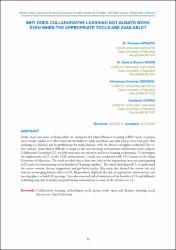Why does collaborative learning not always work even when the appropriate tools are available?

View/
Access
info:eu-repo/semantics/openAccessAttribution-NonCommercial 3.0 United Stateshttp://creativecommons.org/licenses/by-nc/3.0/us/Date
2019Metadata
Show full item recordCitation
Appavoo, P., Sukon, K. S., Gokhool, A. C., Gooria, V. (2019). Why does collaborative learning not always work even when the appropriate tools are available?. TOJDE, 20(4), 11-30.Abstract
Today, more and more working adults are opting for the Open Distance Learning (ODL) mode to pursue
their tertiary studies as it offers them the flexibility to study anywhere, any time and at one’s own pace. But
studying at a distance can be problematic for many learners, with the absence of regular traditional face-toface sessions. Some find it difficult to adapt to this new learning environment and become easily isolated.
Collaborative Learning (CL) can help overcome this isolation and boost learning performance. To investigate
the implications of CL in the ODL environment, a study was conducted with 155 learners at the Open
University of Mauritius. The study revealed that at least one third of the respondents were not participating
in CL and were thus missing on the benefits of “learning together”. The others had adopted CL to understand
the course content, discuss assignments and get better marks. This study also showed that tutors’ role was
vital in encouraging learners delve in CL. Respondents deplored the lack of appropriate infrastructure and
meeting places to hold CL meetings. They also reported lack of awareness of the benefits of CL and difficulty
in finding time due to family and professional commitment as some of the obstacles to CL.
Source
Turkish Online Journal of Distance Education-TOJDEVolume
20Issue
4Collections
The following license files are associated with this item:


















